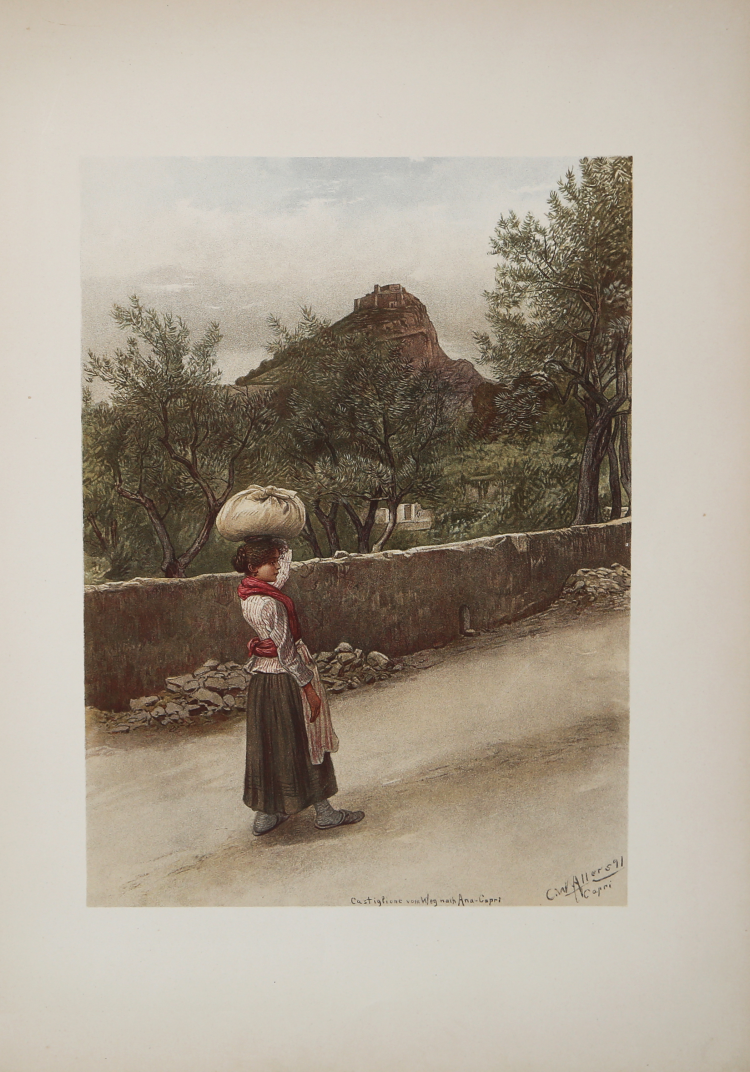



| Reference: | S45822 |
| Author | Christian Wilhelm Allers |
| Year: | 1892 |
| Zone: | Capri |
| Printed: | Karlsruhe |
| Measures: | 240 x 340 mm |


| Reference: | S45822 |
| Author | Christian Wilhelm Allers |
| Year: | 1892 |
| Zone: | Capri |
| Printed: | Karlsruhe |
| Measures: | 240 x 340 mm |
Color lithograph, 1892 signed by W. Allers.
Christian Wilhelm Allers (Hamburg, August 6, 1857 - Karlsruhe, October 19, 1915) was a German draftsman, painter and illustrator. The son of a merchant, he began working as a lithographer and in 1877 moved to Karlsruhe where he continued in that profession. At the Kunstakademie (the state academy of fine arts) he was a student of Professor Ferdinand Keller. Allers became well-known when he published his print collection, Club Eintracht in 1888. Several other books and print collections followed (for example, one on Bismarck), so much so that in the early 1890s he was able to have a villa built in Capri, where he lived for many years, also spending time in Hamburg, Karlsruhe, and traveling the world. C.W. Allers was a naturalist artist. His drawings are rich in detail and have a realistic style.
Perfect state of preservation.
Christian Wilhelm Allers (1857-1915)
|
Christian Wilhelm Allers (Hamburg, August 6, 1857 - Karlsruhe, October 19, 1915) was a German draftsman, painter and illustrator. The son of a merchant, he began working as a lithographer and in 1877 moved to Karlsruhe where he continued in that profession. At the Kunstakademie (the state academy of fine arts) he was a student of Professor Ferdinand Keller. Allers became well-known when he published his print collection, Club Eintracht in 1888. Several other books and print collections followed (e.g., one on Bismarck), so that by the early 1890s he was able to have a villa built in Capri, where he lived for many years, also spending time in Hamburg, Karlsruhe, and traveling the world. In the fall of 1902, he was caught up in a scandal: Friedrich Alfred Krupp, another famous person living on Capri, was accused of homosexuality and pederasty, and Allers with him (Krupp died a few weeks later, probably by suicide). Allers, warned in time, managed to escape before the prosecution began, resulting in a sentence of four and a half years in prison, pronounced in absentia. C.W. Allers was a naturalist artist. His drawings are rich in detail and have a realistic style, often lacking in emotion. Although the drawings look realistic, Allers sometimes added people to the scenes who were not on the scene. In this sense he was not a realist. Technically, Allers often used pencils. His color drawings were usually done in pencil and colored later (pastel, oil...).
|
Christian Wilhelm Allers (1857-1915)
|
Christian Wilhelm Allers (Hamburg, August 6, 1857 - Karlsruhe, October 19, 1915) was a German draftsman, painter and illustrator. The son of a merchant, he began working as a lithographer and in 1877 moved to Karlsruhe where he continued in that profession. At the Kunstakademie (the state academy of fine arts) he was a student of Professor Ferdinand Keller. Allers became well-known when he published his print collection, Club Eintracht in 1888. Several other books and print collections followed (e.g., one on Bismarck), so that by the early 1890s he was able to have a villa built in Capri, where he lived for many years, also spending time in Hamburg, Karlsruhe, and traveling the world. In the fall of 1902, he was caught up in a scandal: Friedrich Alfred Krupp, another famous person living on Capri, was accused of homosexuality and pederasty, and Allers with him (Krupp died a few weeks later, probably by suicide). Allers, warned in time, managed to escape before the prosecution began, resulting in a sentence of four and a half years in prison, pronounced in absentia. C.W. Allers was a naturalist artist. His drawings are rich in detail and have a realistic style, often lacking in emotion. Although the drawings look realistic, Allers sometimes added people to the scenes who were not on the scene. In this sense he was not a realist. Technically, Allers often used pencils. His color drawings were usually done in pencil and colored later (pastel, oil...).
|